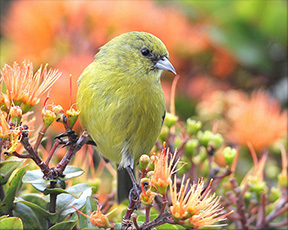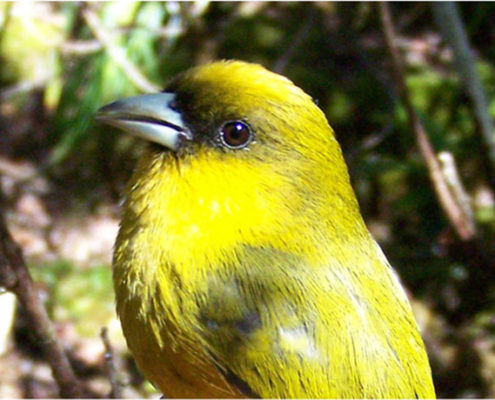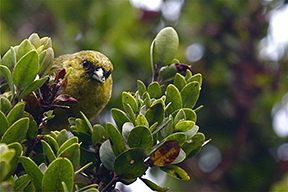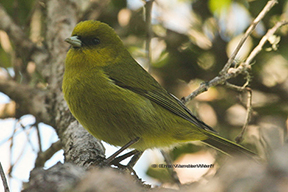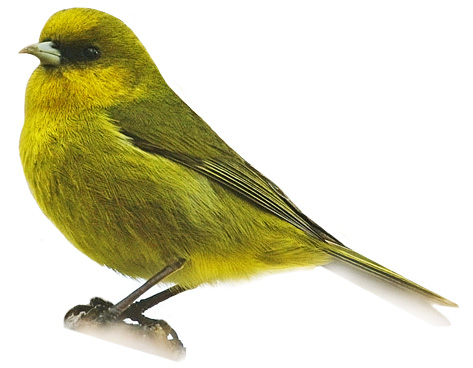
‘Akeke’e
Loxops caeruleirostris
Fossil records suggest that this greenish-yellow honeycreeper with a black mask has inhabited only the island of Kaua’i. This species has a specialized bill – with offset tips similar to those of mainland crossbill species – that allows it to pry open buds of ‘ōhi’a leaves and flowers to search for invertebrates. The species was federally listed as endangered in 2010 due to low numbers and a declining population trend; data from 2018 suggest there are 1,162 birds in the wild (Paxton et al., 2020). The ‘akeke’e population has declined by 98% from 2000 to 2012 (Paxton et al. 2016). KFBRP piloted long-term studies on habitat use and demography in 2011, as detailed in the draft Five-Year Recovery Plan for ‘akeke’e, to investigate causes of the ‘akeke’e decline.
Vegetation surveys and occupancy sampling for ‘akikiki and ‘akekeʻe were conducted at plots across the Alaka’i Plateau in 2012 to assess range-wide occupancy and habitat use (Behnke et al. 2016). Occupancy rates for both species increased from west to east along the plateau, but were low throughout the ranges of both species. Both species were more likely to be found in areas of high canopy.
Ruby Hammond conducted a study (2012-13) to investigate factors that affect reproductive success of native, arboreal nesting songbirds on Kaua‘i. The endangered ‘akeke‘e had high nesting success ( 71 %) relative to other bird species (57 %), and relative to mean nesting success of Hawaiian forest birds (46 %) (Hammond et al. 2015).
Although first described in the 1880’s, there is a paucity of research on the ecology of ‘akeke’e, much of which is summarized in the Hawai’i Comprehensive Wildlife Conservation Strategy ‘Akeke’e Fact Sheet. Very few nests of the ‘akeke’e have been located and observed by biologists, possibly because ‘akeke’e nest high in the terminal branches of ‘ōhi’a trees. The breeding season generally begins in March, and we suspect that the last chicks fledge from their nests by mid-July based on the breeding biology of the ‘akeke’e’s close relative, the Hawai’i ‘ākepa. It is also likely that ‘akeke’e can build multiple nests in a season since most honey-creeper species re-nest after failure of a nesting attempt. Several honeycreeper species will also raise multiple broods of 1-2 eggs per season.
Like most of the native forest birds in Hawai’i, the ‘akeke’e is restricted to high-elevation forests that are in nearly pristine condition on the eastern edge of Koke’e State Park and the Alaka’i Wilderness Preserve. A 2021 study predicted their overall range to be 58km2 and their nesting range to be only 11km2 (Fricker et al. 2021). Although the ‘akeke’e is rare, a careful observer can find this species easiest by scanning the crowns of ‘ōhi’a trees. Once spotted, an observer can spend several minutes watching these birds forage meticulously across the forest canopy. Identifying this species by ear is difficult, as it sounds similar to several other species, including ‘akikiki, ‘anianiau, and Kaua’i ‘amakihi.

